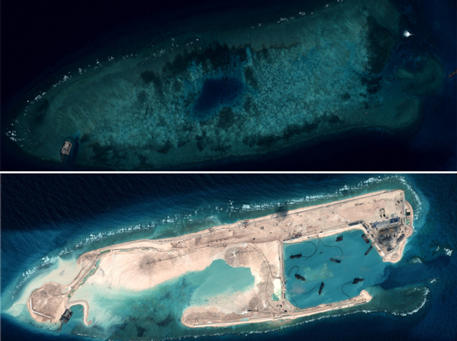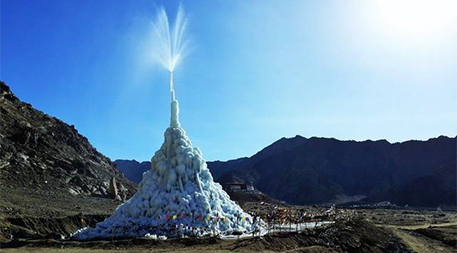December 28, 2015 — Artificial intelligence, testosterone and ship tracking technology probably aren’t on many conservation organizations’ “top things to think about” lists right now. But they should be, suggests a new report in the scientific journal Trends in Ecology & Evolution.
“A Horizon Scan of Global Conservation Issues for 2016,” authored by University of Cambridge conservation biologist William Sutherland and 23 other researchers, practitioners, professional horizon scanners and journalists, offers a list of 15 emerging trends and developments that are not well known but could have big implications — positive, negative or both — for biodiversity on a global scale.
To come up with the list, team members racked their own brains, monitored social media and consulted more than 400 other individuals to come up with a list of 89 topics that have implications for global conservation and that they rated high in terms of probability of occurring, potential impact and/or likelihood of rapidly emerging.
The top issues identified were:

Increasingly powerful computers offer both new opportunities and new threats for biodiversity conservation. Photo by Randy Montoya/Sandia Labs
Artificial Superintelligence
Artificial intelligence can contribute to conservation goals by making it possible to do things like better identify butterflies and boost energy efficiency in buildings. But if machines become smarter than humans, all bets are off as to whether our desired future for ecosystems — or anything else, for that matter — prevails.
Energy Storage and Consumption
Declining battery prices and changes in regulation open the door to rising renewable energy production and consumption. One positive conservation implication is reducing the threat of climate change. On the down side, though, they could contribute to potentially worrisome habitat disruptions due to increased deployment of wind and solar power installations.
Ecological Civilization
China is better known for its environmental challenges — air pollution, desertification, high carbon emissions and more — than for its environmental solutions. In recent years, however, its government has adopted a formal policy of “ecological civilization” — development that respects and protects nature. Specific actions — which could boost the health of China’s environment and provide a model for other countries — include establishing model environmentally friendly villages, conserving areas that provide ecosystem services, factoring ecosystem services into economic reports, and investing in reforestation.
Electric Pulse Trawling
A jolt of electricity delivered to the ocean floor can make harvesting seafood species such as shrimp and flatfish easier and more efficient. Use of the practice is on the rise, suggesting it’s high time to take a look at the unintended consequences it carries for nontarget species and the marine ecosystem as a whole.

This now-shuttered power plant in Norway made electricity using the difference in salt concentration between river water and seawater. Photo by Damian Heinisch/Statkraft
Osmotic Power
Several years ago Norway experimented with producing electricity using the energy released when salt water mixes with freshwater at the intersection of river and sea. The facility turned out to be too expensive to run, however, so it shut down. With growing interest in renewables and technological advances, however, eyes are turning to this electricity source once again. Implications of implementation for biodiversity include disruption of shoreland habitat for power plant construction and operation as well as potential harm from facility wastewater to species unable to tolerate salt.

Using bees to help deliver biological control agents to crops could sicken or kill couriers or nontarget insects and plants. Photo © iStockphoto.com/borchee
Bees as Vectors
One strategy for keeping farm crops healthy involves treating them with biological control agents such as bacteria, viruses or fungi that incapacitate pests or diseases. Some producers have begun using bees to help deliver control agents to crops by having them walk through powder containing the agents before heading out on their flower-foraging flights. The extent to which the approach could sicken or kill couriers or nontarget insects and plants is currently largely unknown.
Arctic Fishing
Climate change is opening the door to the central Arctic Ocean for commercial fish species such as Atlantic cod and yellowfin sole. Currently the five countries bordering the Arctic have agreed to prohibit commercial fishing until policies are in place to protect the species from overfishing. But failure to achieve international agreement for the long haul through the U.N. Convention on the Law of the Sea (which is far from out of the question given existing disagreements among the convention’s parties) could result in a Wild West of fishing in this changing ocean.

Before and after satellite images taken in August 2014 and January 2015 show the emergence of a large island at Fiery Cross Reef in the South China Sea’s Spratly Islands. Images courtesy of CNES 2014/Distribution Airbus DS/IHS
Artificial Islands
Recent years have seen growing interest in construction of artificial islands for purposes such as expanding residential areas or providing sites for military facilities by building up coral reefs with sand and concrete. The process creates major ecosystem disruption in the immediate vicinity and could cause more distant problems by disrupting the ability of corals to thrive, reproduce and spread. Artificial islands also could make currently hard-to-reach natural resources more accessible and therefore more susceptible to depletion.
Testosterone
As guys man up, will fish pay the price? Use of testosterone supplements to boost physical appearance and sexual function is growing rapidly in some affluent parts of the world: In the U.S. alone, the testosterone market went from $18 million to $1.6 billion between 1988 and 2011. We know that many pharmaceuticals are excreted in urine, survive the wastewater treatment process and in some cases disrupt the ability of fish and other living things to function normally. Will testosterone do the same?
Engineered Nanoparticles on Land
Scientists have started assessing possible adverse impacts on aquatic life of nanoparticles such as titanium dioxide, which can end up in wastewater after being used in personal care products or clothing. But what impact might they have elsewhere? Evidence is growing that nanoparticles found in sewage sludge could harm microbes in the soil when the sludge is spread on land for disposal and soil enrichment purposes — with adverse implications that could reverberate throughout the ecosystem.
Ocean Ship Tracking
Advanced technologies and corresponding regulations make it easier than ever to identify, characterize and track the movement of ocean-going vessels. While originally established for safety purposes, the technology holds promise for helping reduce illegal fishing, boost ship compliance with emissions regulations and more accurately calculate environmental footprints of the products we purchase, 90 percent of which spends time on a ship at some point.
Passive Acoustic Monitoring
Innovations in digital recording and transmission now make it possible to monitor sounds from afar. This emerging capability could be applied to the benefit of conservation by making it easier to monitor the presence of species of concern in remote habitats as well as track environmental conditions such as noise pollution. If we can resolve challenges related to managing and analyzing the massive amounts of data produced, it also could be applied to scanning vast areas for audible signs of illegal logging, hunting or fishing.
Synthetic Body Parts
A major threat to many endangered animals is illegal trade in body parts such as horns and bones. Recent advances in 3-D printing and chemical synthesis have combined to make it possible to make synthetic versions of the desired material. Synthetic rhino horn is already a reality, and other permutations such as synthetic tiger bone and synthetic elephant ivory could be just a Kickstarter campaign away. But would flooding the market with synthetic alternatives reduce demand for the real McCoy, or make genuine parts more sought-after than ever? No one knows — but the difference between extinction and survival could hang on the answer.

Artificial glaciers divert water to be used later for agriculture, which may alter nearby ecosystems. Photo courtesy of Ice Stupa Project
Artificial Glaciers
In some part of the Himalayas, residents are diverting water into low spots in the mountains to create artificial glaciers that can later produce meltwater needed for irrigating crops. The strategy could make agricultural lands more productive, reducing the need to disrupt habitat for additional cultivation. But it also alters the movement of water across land and into aquifers, raising the potential for altering nearby desert and other ecosystems and the unique species they support.

Tammar wallabies introduced to New Zealand harbor genetic diversity that has been lost in the animal’s native Australia. Photo by Josh More (Flickr/Creative Commons)
Invasive Species as Gene Reservoirs
In an ironic twist, some species are now more genetically diverse (and therefore more resilient to environmental change) in regions where they’re not native than in places where they are. Should the introduced species be used as a reservoir of genes to diversify decimated populations back home? And what are the implications of seeing them as such for efforts to eradicate or control invasive species that could potentially serve such a function in the future?
“We hope that heightened awareness of these threats and opportunities will encourage researchers, policy makers, and practitioners to consider them, potentially improving the alignment of environmental research and science with policy and practice,” the authors of the report concluded.
![]()
Ensia shares solutions-focused stories free of charge through our online magazine and partner media. That means audiences around the world have ready access to stories that can — and do — help them shape a better future. If you value our work, please show your support today.
Yes, I'll support Ensia!
